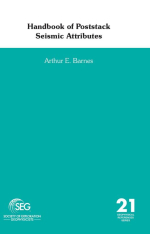Добрый день, Коллеги. Важное сообщение, просьба принять участие. Музей Ферсмана ищет помощь для реставрационных работ в помещении. Подробности по ссылке
Handbook of Poststack Seismic Attributes / Справочник сейсмических характеристик
The Handbook of Poststack Seismic Attributes is a general reference for poststack seismic attributes intended for reflection seismologists in petroleum exploration. The goal of the book is to bring greater understanding and order to the important and rapidly evolving science of seismic attributes, so that geophysicists can apply attributes more effectively to interpret seismic data. To this end, I emphasize what all attributes have in common, what they mean, and what they measure, arguing that the meaning of an attribute should guide both its implementation and its application. I freely judge certain attributes to be useful and others to be useless, and I consider the advantages as well as the shortcomings of attribute analysis. I provide sufficient mathematics to implement the attributes, favoring clarity and simplicity over mathematical rigor. In the manner of a handbook, I cover methods and ideas that are more likely to be encountered in practice, but I make no pretense of being comprehensive. Indeed, ponderous books can be written on topics that are treated here only cursorily, such as spectral decomposition and seismic pattern recognition.
I begin the book by introducing the fundamental ideas that underlie all seismic attribute analysis and reviewing the history of seismic attributes from their origins to current developments. I describe the characteristics of key and familiar poststack attributes, starting with attribute maps and interval statistics, and progressing through to complex trace attributes, 3D attributes that quantify aspects of geologic structure and stratigraphy, seismic discontinuity attributes, spectral decomposition, thin-bed analysis, waveform classification, recursive inversion for relative acoustic impedance, and spectral ratioing for Q estimation. I discuss how attributes are usefully combined through multiattribute analysis through volume blending, cross-plotting, principal component analysis, and unsupervised classification. I end the book with a brief overview of how seismic attributes aid data interpretation, with a look at bright spots, frequency shadows, faults, channels, diapirs, and data reconnaissance. A glossary provides definitions of seismic attributes and methods, and appendices provide necessary background mathematics. It is my sincere hope that this book instills a greater appreciation for seismic attributes, moderated by a clearer awareness of their limitations. <...>




